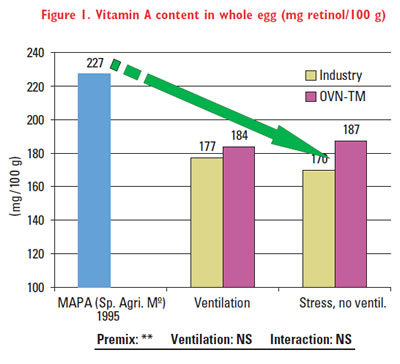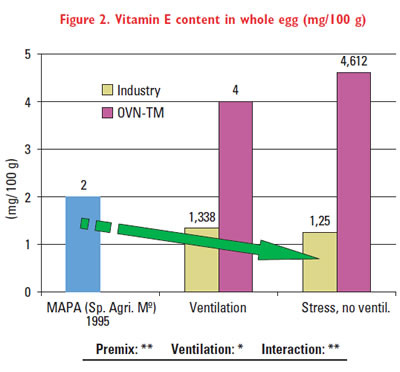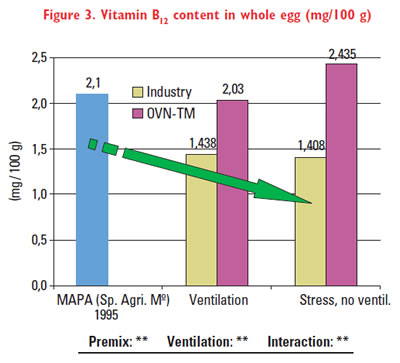



Improving Nutritive Value of Eggs by Feeding Laying Hens an Optimum Vitamin Nutrition (OVN)
Eggs from hens fed diets supplemented with elevated vitamin levels produced eggs with a higher nutritional value than the controls, according to research by M. Pérez-Vendrell and colleagues at IRTA (Reus, Spain) and J.M. Hernández (DSM Nutritional Products).Summary
Eggs are an excellent source of high quality and easily digestible protein as well as a good source of certain vitamins and minerals. Levels of vitamins in eggs are directly linked to the levels in the diet of the hen. Layer feed conversion rates have improved drastically (approx. 40%) during last 30 years so that it is essential to re-evaluate accordingly vitamin levels in feed if we want to provide eggs to consumers with, at least, the same nutritional value than in the past. This paper summarises the effects of two vitamin levels in laying hen diets (average level used in Spain vs. Optimum Vitamin Nutrition level) on the vitamin deposition and quality of eggs. Eggs from hens fed OVN™ diets had significantly higher concentration of vitamins A, E, B1, B2, B12, folic acid, pantothenic acid and biotin, resulting in eggs with a higher nutritional value than their control counterparts.
Introduction
ggs are one of the most complete and versatile foods currently available, being an excellent source of high quality and easily digestible protein as well as a good source of certain vitamins and minerals. Poultry vitamin levels in feed have been historically established by NRC (1994) and ARC (1984) to prevent clinical deficiencies and have changed only little over the last 40 years. During the same period of time, layer feed conversion rates have improved drastically (approx. 40%) based on a higher egg mass production (approx. 30%) and lower feed consumption (approx. 10%), what makes necessary adapt accordingly vitamin levels in feed. An optimum level of vitamins in feed is essential to allow birds to achieve their full genetic potential and enhance health, welfare and therefore productivity. But also the egg industry should not forget that levels of vitamins in eggs are directly linked to the levels in the diet of the hen, contributing to make the egg such a nutritive food product.
Nowadays, safe, tasty, nutritious and appetising food products are demanded by consumers. Retailers attach considerable importance to satisfying these demands. This involves continuous product development to create new value added products. Supporting these assumptions, some consumer surveys in Spain (Hernandez et Seehawer, 2001) have shown that consumers consider the nutritive value of eggs as one of the most important egg quality factors.
All these facts motivated some research where the effect of using two different vitamin levels in layer feed was evaluated. On the one hand, the average vitamin levels used by Spanish egg producers and on the other hand, levels recommended by several worldwide specialists (Barroeta et al, 2002) and described in this paper as Optimum Vitamin Nutrition levels (OVN™).
Materials and Minerals
The purpose of the trial was to study the effect of using different vitamin levels in laying hen diets on vitamin deposition and on egg quality. Layers were subjected or not to environmental stress conditions as produced by a restricted ventilation rate which increased air ammonia concentration. One hundred and twenty eight brown hens of the Hy-Line strain were used.
There were four experimental treatments replicated 16 times and allocated at random by blocks, according to the location in the experimental rooms. The criterion used in choosing blocks was rate of lay, evaluated in the pre-experimental period. Hens of treatments T-1 and T-2 were reared in a room under normal conditions, while layers of treatments T- 3 and T-4 were subjected to environmental stress conditions, produced by a restriction on ventilation rate, that produced an increase in air ammonia concentration.
Layers from treatments T-1 and T-3 were fed a vitamin premix (Table 1) formulated according to the usual practice in Spain (Villamide et Fraga, 1999), whereas birds from treatments T-2 and T-4 were fed higher vitamin levels described in this paper as Optimum Vitamin Nutrition levels (OVN™).
| Table 1 - Composition of experimental vitamin premixes | ||
| Vitamins | T1, T3: Control (mg/kg) | T2, T4: OVN (mg/kg) |
|---|---|---|
| A: Retinol | 8110 UI (16.22g) | 12000 UI (24g) |
| D3: Cholecalciferol | 2160 UI (4.32g) | 3500 UI (7g) |
| E: alpha-Tocopherol | 6.90 | 50 |
| K3: Menadione | 1.43 | 3.00 |
| B1: Thiamin | 0.91 | 3.00 |
| B2: Riboflavin | 3.94 | 7.00 |
| B6: Pyridoxal | 1.63 | 5.00 |
| B12: Cobalamine | 0.0123 | 0.025 |
| PP (B3): Niacin | 21.40 | 50.00 |
| B5: Pantothenic acid | 7.45 | 10.00 |
| M: Folic acid | 0.31 | 1.00 |
| H: Biotin | 0.02 | 0.15 |
| C: Ascorbic acid | 0 | 100 |
The duration of trial included a pre-laying period followed by four periods of four weeks each of laying period (from week 22 to week 38). Egg production, egg weight, mortality, feed consumption, feed efficiency and egg quality parameters were evaluated.
Four different pools of eggs (yolk + white) for each treatment were prepared and sent to DSM laboratories (Basel) to analyse their vitamin content. The oxidative stability of egg yolk was assessed by measuring the non-induced TBARS (Thiobarbituric Acid Reactive Substances) values of 16 egg samples per treatment.
Results and Discussion



Data of vitamin contents found in egg samples are reported in Table 2. As it can be observed, almost all vitamin levels (A, E, B1, B2, B12, pantothenic acid, folic acid, biotin) determined in whole egg were statistically increased when hens were fed OVN premix (but not enough to be considered as vitamin enriched eggs), thus improving in that way the nutritive value compared to control eggs. Vitamin C was not deposited in eggs in any of the four treatments, which is in line with previous unpublished research.
It is interesting to observe that standard eggs produced in Spain (eggs from T-1 and T-3) show a lower level of some vitamins (Figures 1, 2, 3) compared to those levels published for eggs in the official nutritional tables (MAPA, Spanish Ministry of Agriculture, 1995). This fact is probably related to the improvement of layer feed conversion due mainly to better animal genetics and management compared to the past and the non-corresponding adaptation of vitamin levels in feed: the lower the vitamin intake by the hen, the lower the vitamin deposition in the egg. On the other hand, OVN eggs contained a higher level of those vitamins which allowed eggs have a nutritional value close to the one published in official nutritional tables.
| Table 2. Vitamin content determined in whole eggs | ||||||||||||
| Treatment | Vitamin Premix | Room | Stress | Vit A (IU/kg) | Vit E (ppm) | Vit B1 (ppm) | Vit B2 (ppm) | Vit B12 (ppm) | Ca-pantothenate (mg/kg) | Folic Acid (mg/kg) | Biotin (micro g/kg) | Vit C (mg/kg) |
|---|---|---|---|---|---|---|---|---|---|---|---|---|
| T-1 | Control | 1 | No | 5905 | 13.38 | 0.52 | 4.05 | 14.38 | 15.60 | 0.51 | 229.50 | 0 |
| T-2 | OVN | 1 | No | 6147 | 40.00 | 0.58 | 4.08 | 20.30 | 18.38 | 0.71 | 323.50 | 0 |
| T-3 | Control | 2 | Yes | 5660 | 12.50 | 0.52 | 3.85 | 14.08 | 14.30 | 0.47 | 210.00 | 0 |
| T-4 | OVN | 2 | Yes | 6222 | 46.12 | 0.72 | 4.15 | 24.35 | 18.62 | 0.64 | 326.25 | 0 |
|
Premix effect:
|
Control | 5782 b | 12.94 b | 0.52 b | 3.95b | 14.22 b | 14.95 b | 0.49 b | 219.88 b | 0 | ||
| OVN | 6185 a | 43.06 | 0.65 a | 4.11 a | 22.32 a | 18.50 a | 0.67 a | 324.9 a | 0 | |||
| Pr>F | 0.0013 | 0.001 | 0.0022 | 0.0263 | 0.0001 | 0.0029 | 0.0001 | 0.0001 | - | |||
| St.Err | 68 | 0.02 | 0.02 | 0.04 | 0.42 | 0.67 | 0.02 | 4.79 | - | |||
| Table 3. TBARS values determined in egg yolk at the end of the experiment | ||||
| Treatment | Vitamin Premix | Room | Stress | TBARS values (nmol/g) |
|---|---|---|---|---|
| T-1 | Control | 1 | No | 0.308 |
| T-2 | OVN | 1 | No | 0.262 |
| T-3 | Control | 2 | Yes | 0.294 |
| T-4 | OVN | 2 | Yes | 0.285 |
|
Premix effect:
|
Control | 0.301 | ||
| OVN | 0.274 | |||
| Pr>F | 0.3088 | |||
| St.Err | 0.018 | |||
In Table 3, TBARS values determined in egg yolk collected right at the end of the experiment are presented. As it can be seen, lipid oxidation of egg yolks was not statistically affected by type of vitamin-premix, although eggs of hens fed OVN premix showed numerically lower TBARS values (0.274 vs 0.301 nmol/g) than animals fed controldiets.
These results agree with the level of antioxidant vitamin E found in OVN feeds and also with the level of vitamin E in whole eggs (43.06 ppm in eggs of layers fed OVN premix versus 12.94 ppm found in eggs of hens fed control premix). In general, no significant differences on laying hen performance were obtained between birds fed different levels of vitamins.
References
BARROETA, A., CALSAMIGLIA, S., CEPERO, C., LÓPEZ-BOTE, C. and HERNANDEZ, J.M. 2002. Optima nutricion vitamnica de los animales para la produccioón de alimentos de calidad. Ed. Pulso EdicionesS.L. HERNÁNDEZ, J.M. and SEEHAWER, J. 2001. Egg quality as part of a wider food quality concept: consumers‘ feedback in Germany and Spain in 2000. XVth European Symposium on the Quality of Poultry Products, Turkey.
VILLLAMIDE, M.J. and FRAGA, M.J. 1999. Composition of vitamin supplements in Spanish poultry diets. British Poultry Science, 40: 644-652.
March 2010








